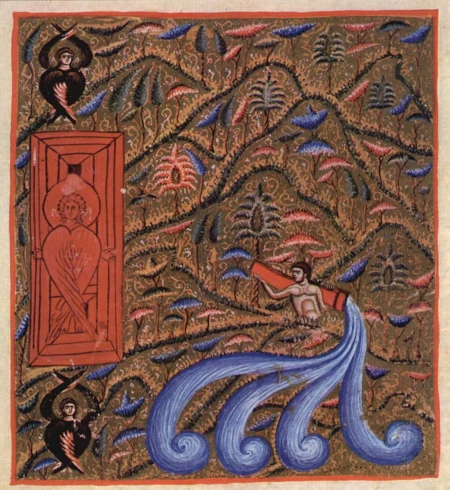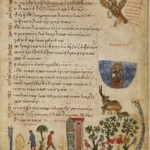According to the Judeo-Christian Bible, Eden is a paradise, a garden in which the creator, the supreme God Yahweh, placed the first humans, Adam and Eve. In a previous post, I argued that the creation of the first humans took place somewhere else entirely, namely in southeastern Africa. Only after some time were the first humans moved eastward, to the Garden of Eden.
This is explained, for example, in the apocryphal Book of Jubilees 3:9-10:
9. And when Adam had lived forty days in the land where he was created, We took him into the Garden of Eden, and his wife entered the threshold of Eden eighty days…
10. later…
So, where exactly was Eden?
The Bible also explains this, specifically Genesis 2:10-15:
10. A river flowed out of Eden to water the garden, and from there it divided, becoming four rivers.
11. The name of the first was Pishon; this is the one that flows around the whole land of Havilah, where there is gold.
12. The gold of that land is excellent; there is also sweet resin and red stone.
13. The name of the second river was Gihon; it flows around the whole land of Cush.
14. The name of the third river was Hiddekel; it flows east of Asshur. The fourth river was Perath.
15. So the Lord God took the man and placed him in the garden of Eden to till it and keep it.
We have a clear account that a river flowed out of Eden, which divided into four:
– The Pishon flowed around the whole land of Havilah, where there was gold, sweet resin, and red stone.
– Gihon – “encircling the entire land of Cush,” a name associated with Ethiopia.
– Hiddekel is the modern Tigris. It originates in the Eastern Taurus Mountains in Turkey and flows through Syria (40 km border section) and Iraq, joining the Euphrates near Al Qurnah in its lower reaches to form the Shatt al-Arab, which flows into the Persian Gulf.
– Peret is the modern Euphrates. It flows through Turkey, Syria, and Iraq in its lower reaches near Al Qurnah, joining the Tigris and forming the Shatt al-Arab, which flows into the Persian Gulf.
Hiddekel and Peret are quite well-placed, but the Pishon is in the unknown land of Havilah, and Gihon is likely the Gion River in Ethiopia — the Blue Nile. Regardless, this doesn’t fit with contemporary theories about Eden’s location west of Mesopotamia, near the Persian Gulf, but does it really?
Juris Zarins identified the Gihon with the Karun River in Iran and Kush with the land of the Kassites, which encompassed a Mesopotamian area that is repeatedly flooded by the Tigris and Euphrates rivers. The Karun discharges into the same general area at the head of the Persian Gulf as the Tigris, Euphrates, and Wadi al-Batin (suggested as the identity of the Pishon, the fourth river of Eden). This view is partly inspired by Herodotus, who thought there was both an African Ethiopia and an Asiatic Ethiopia.
The Sefer haYashar, a medieval Hebrew midrash, asserts that in the time of Enos, grandson of Adam, the river Gihon was subject to a catastrophic flood due to the wickedness of man.
The rabbinic tradition does not interpret rivers literally, instead, they are believed to represent honey, milk, balsam, and wine. Genesis Rabbah identifies the rivers as four corners of the world: Pishon as Babylonia, Gihon as Media, Hiddekel as Greece, Euphrates as Rome. It also states that all waters in the world flow from the foot of the Tree of Life.
Similarly to Judaism, Islam treats the rivers of Paradise (anhār al-janna) as carrying the honey, milk, water, and wine (cf. Q 47:15). However, Hosseinizadeh remarks that these are not the same rivers as in the Bible, since there are four types of rivers, not four rivers in this verse.
Regardless of the views of mystics and religious prophets, I would like to look at this topic from a pragmatic perspective. Personally, I believe that the geographical and religious location of Eden is not without merit, as the current search for the four rivers of Paradise wrongly focuses on the current state of the world.
In my opinion, it is important to consider that the biblical Eden existed long before the last ice age, which ended about 11,500 years ago, and before the great flood, which occurred about 12,500 years ago. The approximate dates of these two events are similar and are likely one and the same.
In this case, before the great flood, sea levels were much, much lower, which suggests that the present-day Persian Gulf, Gulf of Oman, Gulf of Aden, and Red Sea were dry land, as was part of the Arabian Sea. This may also suggest that the Gihon River flowed through present-day Saudi Arabia and Ethiopia, joining the Euphrates and Tigris.
The Pishon River remains difficult to decipher.
On the other hand, satellite images of the confluence of the Euphrates and Tigris rivers have revealed the buried beds of two rivers, which match the biblical description. One of these rivers ran southwest through present-day Saudi Arabia, the other northeast toward the Caspian Sea.
It is possible that the Garden of Eden was actually located in southern Mesopotamia, but this cannot be confirmed yet.
As always, I leave the answer to today’s reflections to each individual.
See also: https://en.wikipedia.org/wiki/Garden_of_Eden






we dont even know that the Eden really exited…
its in Charpatian Basin . ROMANIA